Durabook R11L
Value-priced version of Durabook's popular R11 rugged tablet line omits little, offers much
(by Conrad H. Blickenstorfer; photography by Carol Cotton)
Durabook has long been among the leaders in rugged tablets, making available a succession of durable, special-purpose tablet computers for a wide range of markets. Currently, their tablet portfolio consists of the ultra-rugged Durabook U11 and the high-performance tugged R11, both offering spacious displays. Rugged design comes at a price, however, and so Durabook added the R11L as a value offering starting at just US$1,399, less than some high-end smartphones.
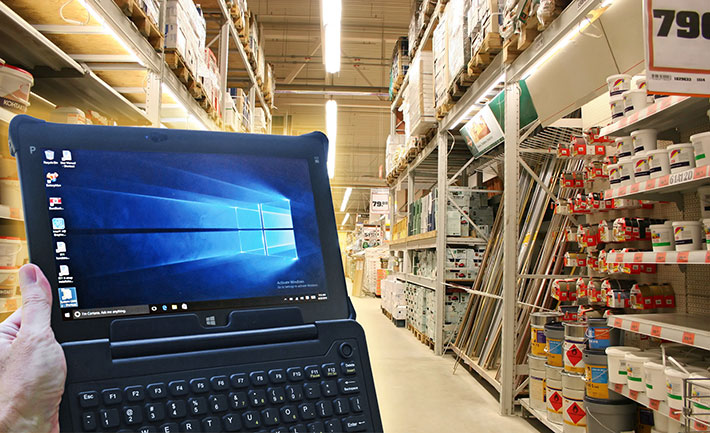
Both the U11 and the R11 line of Durabook tablets have 11.6-inch screens. We've long felt that Microsoft Windows works best on larger displays, and Durabook shares our opinion. "The eleven-inch space is proving to be the sweet spot for rugged tablets," said Tom Wang, COO, Durabook Americas. "While ten-inch devices are also popular, the smaller screen and limited ability for customization are issues our customers have raised." Wang considers the 11.6 inches they have standardized on with their tablets "a screen size that is ideal for viewing and engaging with applications.
As far as Durabook's R11 platform goes, it doesn't look like a rugged product, and definitely not like one of the heavily armored vertical market tablet designs of the past. That's likely because all those hundreds of millions of consumer tablets selling every year have redefined customer expectations. Just like popular Sport Utility Vehicles are both tough and nicely designed, rugged tablets must be durable and functional, but it doesn't hurt if they're also handy and attractive.
Mission objective: A tough, elegant tablet at a reasonable price
Durabook has been making high-quality semi-rugged and rugged tablets since long before the iPad came onto the scene almost a decade ago. Together with tablets from Getac, Zebra, DT Research, Panasonic and others, the Durabook R11 platform is part of a new breed of Windows devices that are fashionably thin and light, use capacitive multi-touch, have sufficient onboard I/O, yet are much tougher and much better suited for business and the field than fragile consumer tablets. These rugged tablets combine contemporary looks with state-of-the-art Intel processors, the full Windows experience, and enough opportunity for customization to make them suitable for virtually any job.
So here's what customers get if they decide to go with the Durabook R11L:
 Overall design — Durabook used the current tablet design language of glass covering the entire surface. But they added protective rubber strips along the sides and four prominent, blocky corner rubber guards that visually communicate significant toughness and also give a much more solid feel to the tablet. As a result, the Durabook R11L looks tough, but also as sleek and hi-tech as the latest consumer tablets.
Overall design — Durabook used the current tablet design language of glass covering the entire surface. But they added protective rubber strips along the sides and four prominent, blocky corner rubber guards that visually communicate significant toughness and also give a much more solid feel to the tablet. As a result, the Durabook R11L looks tough, but also as sleek and hi-tech as the latest consumer tablets.
Size and weight — with most industrial and enterprise customers using Windows on tablets and Windows 10 works best on a wide-format and relatively large display, Durabook chose an 11.6-inch screen with a 16:9 aspect ratio. That provides a good deal more display real estate than the common 10-inch consumer tablets. The R11L is thicker than consumer tablets (0.8 inches) because it's rugged and has the ports a full Windows tablet needs. It weighs about 2.8 pounds, considerably more than a consumer tablet, without, however, feeling too heavy.
Display — Tablet and smartphone displays have become superb, and so Durabook gave the R11L a top-notch display with perfect viewing angles. Since some customers use their tablets outdoors, Durabook offers an optional 500-nit DynaVue sunlight-readable display.
Touch screen — Since all modern consumer smartphones and tablets have ultra-responsive capacitive multi-touch screens, the R11L has one, too. In addition, since the tablet may be used outdoors where it's cold and wet, it can be used with a glove, stylus, or a finger, even in the rain.
Connectivity — While iPads only have one port and no memory card slot, and most other consumer tablets have just a couple of micro ports, the Durabook R11L has two full-size USB 3.0 ports and a card slot.
Ruggedness — The very reason the R11L exists is because it must be tough enough to survive spills and drops and other calamities. So even though the R11L is a value-priced offering, it's just as tough and durable as higher-end R11 versions.
Performance — Durabook gave the R11L a processor designed to meet the requirements of typical warehouse and logistics applications. That saves customers money compared to the cost of the more expensive CPUs in other R11 models.
Price — Ruggedized industrial and enterprise market computers have traditionally carried a high price tag. With the R11L, Durabook offers a tough, high-quality tablet at very reasonable cost.
The above is what Durabook had in mind when creating the value-priced R11L. Now let's take a closer look.
Design, look, and feel — elegant utility
Below you can see the Durabook R11L from the top and all four sides. It's an undeniably elegant and attractive design with a glass front, a black plastic case, and very nicely integrated black rubber bumpers. The bezel area around the display is wide enough to hold the tablet without inadvertently issuing a touch command, and except for the slightly protruding rubber bumpers there is no border for fingers to bop into while operating the tablet. An internal magnesium alloy chassis means the tablet doesn't creak, flex, or twist at all, greatly contributing to a gratifying feel of solidity and quality.

On top of the unit is the grill for the small fan that comes on when it's needed. Have no fear about potential water damage because of this. The fan itself is waterproof and the fan compartment is sealed against the actual interior.
The left side features the power button, a volume rocker, and a Kensington lock slot. Yes, physical security is a good thing.
On the bottom is a surface-mount "Pogo" docking connector that provides power pass-through, HDMI, serial, and USB 3.0, as well as RF pass throughs for WWAN and GPS, and is for use with one of the two available docks. There is also the DC-in jack that we wish were on the side, and two mounting/security screw holes.
Rugged tablets generally don't excel in wired connectivity due to space reasons, and sealing requirements often mandate designs with as few (potentially leaky) openings as possible. Enterprise customers, however, demand a degree of onboard connectivity, especially in tablets running Windows.

As a result, the R11L offers more connectivity than most consumer tablets, but not as much as a notebook or thicker tablets. Almost all I/O is concentrated in a recessed area on the right side of the tablet. You get two full-size USB 3.0 ports, an SD/SDHC/SDXC card slot and a SIM card slot (a) reversible USB Type C port is on our wish list for the next rev). In addition, there's Intel WiDi (Wireless Display) for wireless connection to monitors, TVs and projectors equipped via a WiDi adapter.
There will undoubtedly be customers who would have liked to have an RJ45 LAN jack, HDMI, or perhaps a legacy serial port onboard the tablet, but this is one of the compromises Durabook chose to make. There is, however, an expansion connector that includes power pass-through, dual USB 2.0 and RS232, and can be used for a variety of modular options. Those include a low and high frequency RFID reader, a combination mag stripe and Smart Card reader, a dedicated Smart Card reader, an RJ45 module, and a combination RJ45/RS232 and Smart card reader.

There are also two available docking stations (office and vehicle) that provide not only additional USB 2.0 and 3.0 ports, but also HDMI, RJ45 LAN and RS232 serial. The vehicle dock offers the standard VESA mounting hole pattern compatible with numerous mounting options, as well as a locking mechanism.
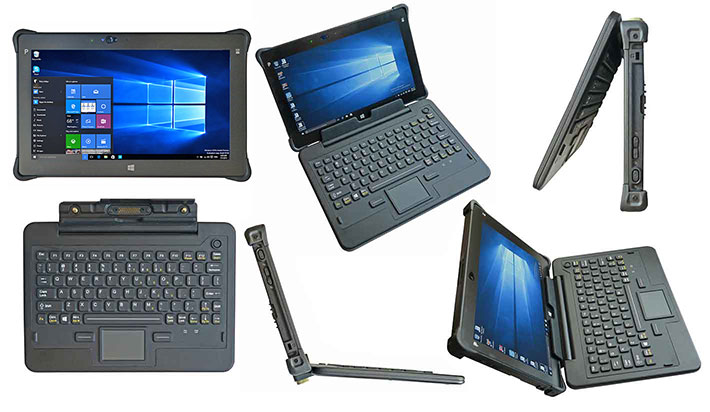
Also worth noting is the optional keyboard (see above) that converts the R11L into a 2-in-1 hybrid. You insert the tablet into the sturdy hinge-base on the keyboard, tighten two thumb wheel screws. and — voilą — instant notebook computer. If the keyboard is not needed, undo the screws and the R11L is a handy, slender tablet again. Two-in-one.
A look inside — solid as a rock
While the outside of the R11L is all sleek and slender, and appears like a slightly thicker consumer market tablet with extra corner guards, inside the R11L is all business. That starts with the battery that is recessed into the backside of the tablet so it can quickly and easily be replaced. Internal, non-replaceable batteries as are the norm in consumer tablets would be unacceptable to most business users. The battery is part of the design and doesn't have a separate cover over it. A friction lever with a push button activator is used to securely hold the battery in place. It is unlikely that it'll ever work itself loose accidentally.
Since there is no battery compartment cover, the battery contact area has a rubber seal that presses against the magnesium frame to make a watertight seal. Whenever replacing the battery, make sure the seal is fully intact. The slender (3/8-inch) battery itself is a Lithium-Ion design rated at 11.1 Volt, 3.95 Ahr, for a total of 43.8 watt-hours.
Instead of having individual access doors in the backside/bottom of the tablet to get to RAM, wireless and other areas, the entire backside comes off. It consists of a thin but tough elaborate plastic cover held in place with about 20 Philips screws of various sizes. Below you can see the R11L with its bottom plate removed and sitting beside the tablet.
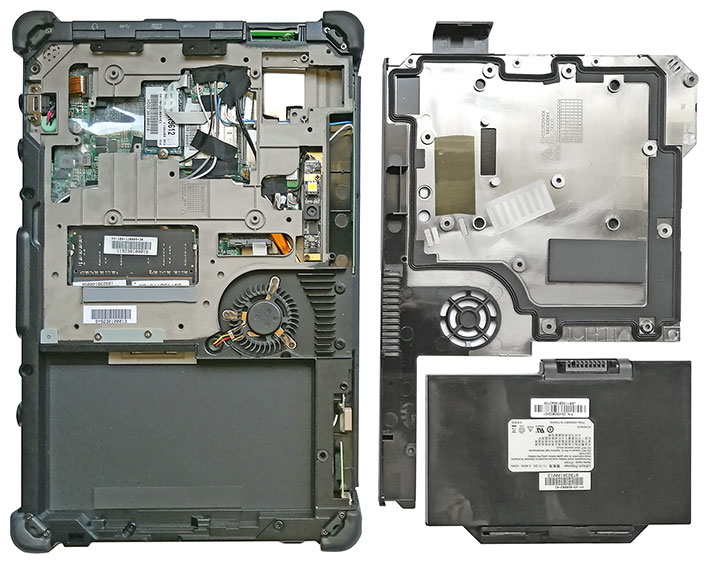
As can be seen, the tablet is built around a thick, intricate and very rigid magnesium frame. The frame/chassis has cutouts for access to replaceable modules.
Now keep in mind that Durabook considers the R11L "rugged" and claims IP65 sealing, which means it must be able to handle low-pressure water jets from all directions.
At first sight that doesn't seem possible with a thin plastic back cover that has a number of smaller and larger cutouts and openings. But then you realize that the back cover has a multi-lipped rubber pressure seal attached to it that then presses against the magnesium internal frame of the R11L. This means that about 70% of the area is totally sealed to the outside whereas the rest is technically part of the exterior of the tablet. Outside are the fan and heat exchanger, the speaker, antennae, and a number of the attachment screws. The screws that are inside the sealed area have little rubber o-rings on them to keep liquids out. It's a clever, intricate design that makes for easy access and ease of servicing, customizing and reconfiguration. But it's also a design that relies on meticulous attention to all the seals and o-rings any time the back cover is removed.
Below is a closer look at how Durabook's engineers placed the around the perimeter of the tablet for best possible performance and least interference. Also note the highly effective and easily replaceable protective corner bumper.

Targeted performance
While higher end R11 tablets have 8th Generation Intel Core processors to handle the complex computing and graphics load found in many industrial and field service markets, the R11L is configured as a value offering for markets like retail, logistics and hospitality and applications like workforce management, asset/inventory management, 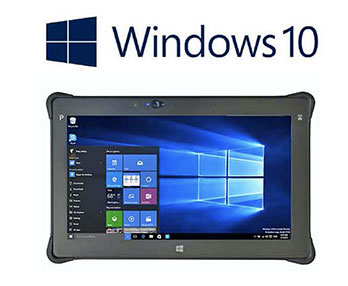 mobile POS, line-busting, in-aisle assistance, and table service. Those tasks do not have the same high performance requirements, and that's what made a good part of the R11L's savings compared to higher-end R11s possible (there are also lower RAM and mass storage limits).
mobile POS, line-busting, in-aisle assistance, and table service. Those tasks do not have the same high performance requirements, and that's what made a good part of the R11L's savings compared to higher-end R11s possible (there are also lower RAM and mass storage limits).
The Durabook R11L comes with an Intel Pentium 4417U, a chip that costs only half as much as the processors used in the higher-end R11 models. The Pentium 4417U only has two cores instead of four, it doesn't have turbo speed, it has less cache, and it doesn't have some of the special technologies Intel bakes into its high-end chips. However, the Pentium 4417U is no lightweight. It is not an Atom chip; it is from the same "Kaby Lake-R" line as all the Core processors. Performance is lower, but in no way weak.
To see what kind of performance the Durabook R11L provides with its dual-core Pentium 4417U processor, we ran our standard benchmark suites, Passmark Software's PerformanceTest version 9.0, as well CrystalMark for confirmation and single core performance information. For comparison and to provide an idea where the Durabook R11L stands, we included benchmark results of a top-end Durabook R11, the Durabook U11 tablet, and three other notable competitors in the rugged tablet market.
The results are as follows:
|
Durabook R11L Benchmarks and Comparisons
|
|
PERFORMANCE COMPARISON
|
Durabook
|
Durabook
|
Durabook
|
DT Research
|
Ruggon
|
Zebra
|
|
Model
|
R11L
|
R11
|
U11
|
DTR 301X
|
PX501
|
XSlate L10
|
|
Device type
|
Rugged tablet
|
Rugged tablet
|
Rugged tablet
|
Rugged tablet
|
Rugged tablet
|
Rugged tablet
|
|
Screen size
|
11.6-inch
|
11.6-inch
|
11.6-inch
|
10.1-inch
|
10.1-inch
|
10.1-inch
|
|
Processor Type: Intel
|
Pentium
|
Core
|
Core
|
Core
|
Core
|
Pentium
|
|
Processor Model
|
4417U
|
i7-8550U
|
7Y75
|
i5-8550U
|
i5-7300U
|
4200
|
|
CPU Cores/Threads
|
2/4
|
4/8
|
2/4
|
4/8
|
2/4
|
4/4
|
|
CPU Speed
|
2.30 GHz
|
1.80 GHz
|
1.30 GHz
|
1.80 GHz
|
2.60 GHz
|
1.10 GHz
|
|
CPU max turbo
|
no turbo
|
4.00 GHz
|
3.60 GHz
|
4.00 GHz
|
3.50 GHz
|
2.50 GHz
|
|
Thermal Design Power (TDP)
|
15 watts
|
15 watts
|
4.5 watts
|
15 watts
|
15 watts
|
6 watts
|
|
CPU Mark 9.0
|
3,237.6
|
8,127.7
|
3,615.6
|
8,658.0
|
5,359.4
|
2,054.,7
|
|
2D Graphics Mark 9.0
|
530.2
|
796.8
|
447.8
|
625.9
|
607.4
|
239.0
|
|
Memory Mark 9.0
|
1,518.5
|
2,385.2
|
2,109.1
|
2,379.6
|
2,468.4
|
1,040.7
|
|
Disk Mark 9.0
|
3,596.0
|
12,319.2
|
3,826.2
|
23,816.7
|
3,126.4
|
4,344.2
|
|
3D Graphics Mark 9.0
|
712.0
|
1,137.0
|
691.5
|
1,200.2
|
518.8
|
355.4
|
|
Overall PassMark 9.0
|
2,204.4
|
3,729.5
|
2,084.1
|
3,601.9
|
2,861.6
|
1,151.3
|
|
ALU
|
35,973
|
70,096
|
39,309
|
71,046
|
53,905
|
37,901
|
|
FPU
|
36,232
|
52,739
|
32,013
|
58,384
|
52,790
|
26,375
|
|
MEM
|
29,294
|
58,059
|
34,472
|
73,714
|
46,872
|
27,841
|
|
HDD
|
46,861
|
44,310
|
39,733
|
71,929
|
37,145
|
38,446
|
|
GDI
|
11,247
|
19,240
|
10,797
|
5,211
|
13,578
|
5,663
|
|
D2D
|
4,305
|
5,036
|
4,431
|
5,211
|
6,318
|
2,764
|
|
OGL
|
8,403
|
11,438
|
7,464
|
10,596
|
11,753
|
3,803
|
|
Overall CrystalMark
|
172,315
|
260,918
|
168,219
|
311,547
|
222,361
|
142,793
|
The results are pretty clear. With most modern software, four processor cores can do more than two, and being able to resort to very high "turbo" clock frequencies helps as well. The Pentium 4417U neither has four cores nor turbo boost, and so it has to make do with what it has. Sure, an R11 equipped with the fastest available processor is about 70% quicker overall than the R11L, but Durabook's value-priced R11L is still plenty quick enough for the warehouse and logistics markets Durabook created this tablet for.
But what about Zebra's L10 tablet you may ask; it has four cores as well but scores much lower. That's because while the Zebra tablet (which is also available with much higher performance chips) also has a Pentium processor like the R11L, Pentium isn't equal Pentium in Intel's world. The one used in the Zebra tablet is actually an Atom processor.
Battery life
Battery life is crucial in rugged tablets, especially in deployments where there's no opportunity for a quick recharge. The Durabook R11L's battery is externally accessible and can quickly be hot-swapped for a fresh one, but who wants to carry around spare batteries? So how does the Durabook R11L do with battery life? Durabook's spec sheets claim eight hours both for the standard R11 as well as for the value-priced R11L.
|
DURABOOK R11L Power Draws (at idle)
|
|
Backlight level
|
Darkest
|
Recommended
|
Brightest
|
|
Max Battery
|
4.9 watts (8.9 hrs)
|
6.9 watts (6.3 hrs)
|
7.9 watts (5.5 hrs)
|
|
Max Performance
|
5.1 watts (8.6 hrs)
|
7.0 watts (6.3 hrs)
|
9.1 watts (4.8 hrs)
|
We used PassMark's BatteryMon to find out. With the Windows 10 slider moved all the way to "Best battery life" mode, and brightness set to 0%," we saw a minimum of 4.9 watts. With the backlight set to 50%, it was 6.9 watts, and with the backlight at "100%" 7.9 watts. Dividing the full available 43.8 watt-hours of a fully charged battery by the lowest observed battery draw of 4.9 watts would indicate a theoretical battery life of 8.9 hours.
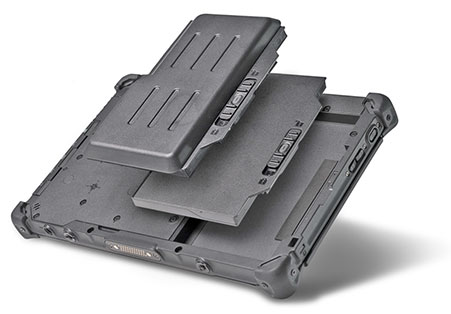 Putting the Windows 10 slider to "Best performance" and setting the backlight to 0%, power draw was 5.1 watts, just a tad higher than in battery conservation mode. With the backlight set to the 50% level, it was 7 watts, and with the backlight at 100% 9.1 watts. This means that in "Best performance" mode and backlight as bright as Windows sets it, theoretical battery life drops to just under five hours.
Putting the Windows 10 slider to "Best performance" and setting the backlight to 0%, power draw was 5.1 watts, just a tad higher than in battery conservation mode. With the backlight set to the 50% level, it was 7 watts, and with the backlight at 100% 9.1 watts. This means that in "Best performance" mode and backlight as bright as Windows sets it, theoretical battery life drops to just under five hours.
Bottomline: the Durabook R11L can last the claimed eight hours on a charge (and a bit more), just as the company claims. But using the tablet in "best performance" mode and with screen brightness cranked all the way up — and the R11L has a rather bright screen — the smallish battery drains fairly quickly. Which is probably why Durabook offers has an optional high-capacity battery with twice the watt-hours.
There usual caveat: benchmark power drawdown simply measures power draw of the device idling along. In real life use in the field, the tablet may go from periods of maximum load to going to sleep. Actual battery life can therefore vary dramatically.
Dual cameras
The Durabook R11L has front and rear cameras, as is standard on most modern tablets. On the front is a 2-megapixel webcam. The rear camera is for picture taking and documentation. It has an 5-megapixel imager, and the pictures we took came out in 4:3 aspect ratio 2,592 x 1,944 pixel resolution, exactly 5-megapixel. We used the cameras on our review unit via the standard Windows 10 Camera application. Image settings allowed selecting resolutions ranging from 320 x 240 up to full 5mp for the documentation camera, with the same menu being used for the webcam. Both cameras can be used for stills as well as for video.
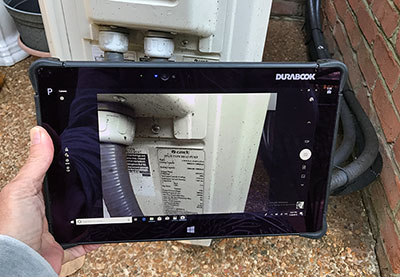 As we've repeatedly mentioned over the years, our experience with cameras integrated into rugged vertical market handhelds and tablets has generally been underwhelming, with most lagging well behind what's available in smartphones dedicated and point & shoot cameras. The situation is getting better, probably in part due to pressure from customers who by now are used to consumer smartphones and tablets equipped with very good cameras.
As we've repeatedly mentioned over the years, our experience with cameras integrated into rugged vertical market handhelds and tablets has generally been underwhelming, with most lagging well behind what's available in smartphones dedicated and point & shoot cameras. The situation is getting better, probably in part due to pressure from customers who by now are used to consumer smartphones and tablets equipped with very good cameras.
We were pleased to find that the rear-facing documentation camera of the R11L is quite good. After a bit of practice, the test pictures we took with the device were suitable for most field documentation tasks. We're not talking iPhone or high-end Android smartphone quality, but good enough.
The Windows Camera app user interface is limited, but Durabook did implement manual focus and manual brightness, both via onscreen sliders. In picture taking mode, you can select from still, video, document and whiteboard modes, turn geo-tagging on and off, set the flash mode, and select either the front or the rear camera. The settings mode is limited to image resolution and storage location.
The pictures below were shot with the Durabook R11L in its highest resolution mode. Click on the image to bring up a full-size version.

The R11L documentation camera is capable of taking decent pictures. There is good sharpness and image detail, and little of the massive compression that often renders pictures from such integrated cameras useless due to artifacting. Patience is needed at times, as the camera takes a bit of time focus, so there's some shutter lag.
Video is better than what we've seen from cameras integrated into rugged devices even two or three years ago. The camera generally doesn't fall behind and the maximum 1920 x 1080 recording format remains useful, even at just 30 frames per second. All that said, today's smartphones have completely spoiled consumers with their superb cameras and sophisticated imaging apps.
Note that camera applications that come with mobile operating systems are often replaced with third party software optimized for certain imaging tasks, or developers and systems integrators include camera and video functionality directly into custom software.
Large, vibrant display
The R11L's 11.6 inch screen offers a generous amount of display real estate — almost a third more than that of a standard iPad, and several times as much as even the biggest smartphone. For a Windows device size matters, especially when you wear gloves or use classic apps. 1920 x 1080 pixel resolution — 190 pixels per inch — makes for a crisp and sharp display. The screen offers 10-point capacitive multi-touch technology, and we believe an optional active digitizer is available. That's a good option to have when one needs more precision than finger touch alone.
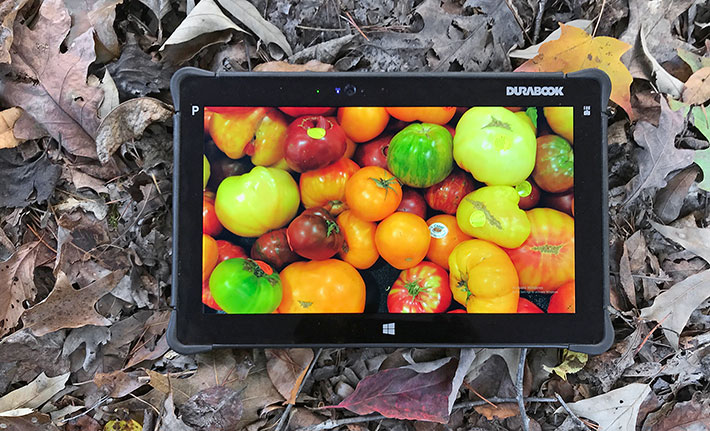
The R11L also seems to come with either one of two types of displays. The standard version offers 360 nits brightness, which is brighter than your average laptop and more than adequate for indoor operation. For frequent outdoor use, there's an optional "Dynavue" sunlight-readable display that uses optical bonding to reduce internal reflectivity and offer 500 nits luminance (our review unit was so equipped and we measured 600 nits).
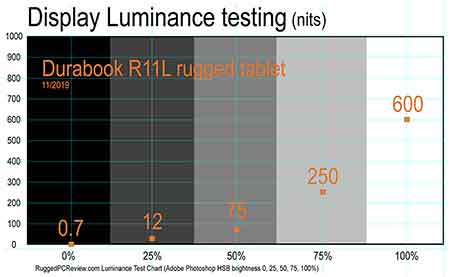 For the past decade and a half, almost all computer screens have been of the "glossy" variety, because glossy displays make for vibrant color.
For the past decade and a half, almost all computer screens have been of the "glossy" variety, because glossy displays make for vibrant color.
One issue with glossy screens is that they are prone to reflections, especially outdoors. That's why some manufacturers offer matte or semi-matte screens that are less affected by reflections. Too much matting, however, diffuses light and the screen becomes, again, less readable. How well did Durabook handle these display issues with the R11L?
To demonstrate how it works in practice, we did a series of outdoor comparison pictures with an Apple iPad Air 2 tablet (which has a very good screen with luminance in the 450 nits range).
The first picture shows the two tablets outdoors on a bright Tennessee mid-morning in early November. Both display backlights were cranked up to maximum brightness, and both remain very readable. The Durabook display is noticeably brighter. The glossy capacitive touch surfaces of both tablets show mild reflections.
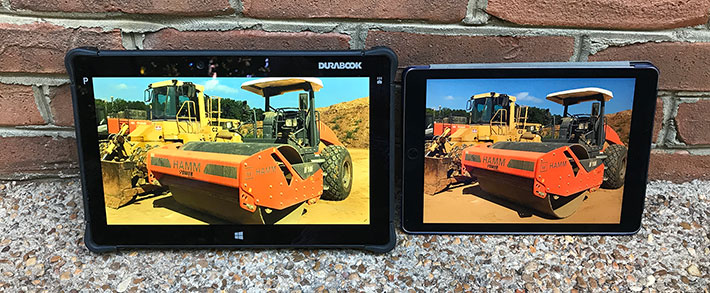
Below is another set of pictures with the tablets laying flat on the ground, facing the sky. Reflections are more noticeable on both tablets. However, unlike some displays where such reflections make the screen unviewable, both tablets remain remain very usable.
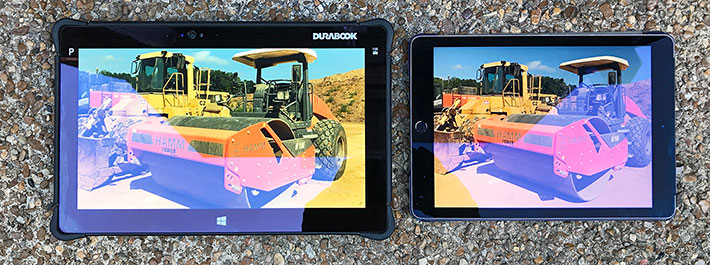
The final set of comparison pictures shows both tablets on the ground again, but viewed from an angle. This is where viewing angle comes into play. Neither tablets suffers from color or contrast shifts, but the Durabook R11L remains bright and easy to view whereas the iPad's image looks dimmer when viewed from that angle.

Overall, the Durabook R11L display is excellent. It is large enough to use Windows comfortably, and sharp enough even for complex applications that require easy viewing of small details. The display offers good color, and no degradations of any kind when viewed from an angle. The standard display should be plenty bright enough for shop floor or retail use. For outdoor use we'd recommend the optional Dynavue display.
Ruggedness — impressive
Durabook's target markets for the R11L are retail, logistics and hospitality and applications like workforce management, asset/inventory management, mobile POS, line-busting, in-aisle assistance, and table service. That means most R11L tablets won't be used in the kinds of extreme environments (like military, public safety, etc.) that Durabook's ultra-rugged U11 was designed for. Durabook, however, made sure to make the R11L plenty tough enough for its intended deployments.
For drops, testing is conducted in modified accordance with the procedures described in MIL-STD-810G, Method 516.6, Procedure IV. Drops are from a height of 48 inches onto 2-inch plywood over concrete, with the unit powered on. Being able to survive four-foot drops is relevant because that is roughly the height the tablet would fall if it slipped out of the hands of someone operating it in a standing position.
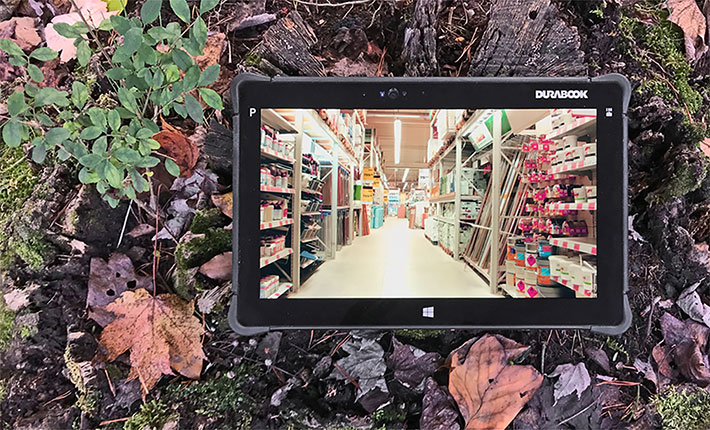
Durabook also states shock and vibration resistance in testing similar to MIL-STD-810G, Method 514.6, Procedure I, Category 24, Fig 514.6E-1 which vibrates the unit while it is powered on at prescribed frequencies for an hour per axis.
On the sealing front, Durabook claims IP65-level ingress protection. The "6" means complete protection against dust, and the "5" means protection against low pressure water jets from all directions. What that means, is that the R11L can handle any degree of rain, but it shouldn't be hosed down with a pressure washer or submerged into water. Needless to say, the experts here at RuggedPCReview felt that the R11L looked like it could survive a good dunk. And it did (see below).

The operating temperature range is given as -4 to 131 degrees Fahrenheit (-20 to 55 centigrade). That's plenty good enough for most conceivable operating environments, including commercial freezers.
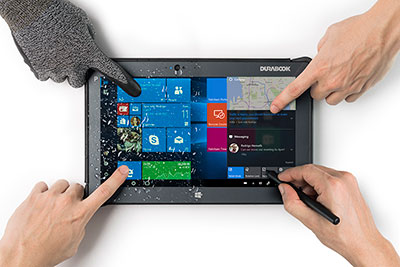 Do note that Twinhead, Durabook's mother company in Taiwan, has decades worth of experience making rugged computers. In the past, Twinhead made all those rugged and ultra-rugged General Dynamics Itronix notebooks, and Twinhead remains a major rugged equipment OEM to a lot of system integrators and resellers around the globe. They know what they're doing.
Do note that Twinhead, Durabook's mother company in Taiwan, has decades worth of experience making rugged computers. In the past, Twinhead made all those rugged and ultra-rugged General Dynamics Itronix notebooks, and Twinhead remains a major rugged equipment OEM to a lot of system integrators and resellers around the globe. They know what they're doing.
Apart from the given specs, our detailed examination of the R11L revealed an exceptionally sturdy design and construction. The rigid internal magnesium chassis keeps the unit from flexing, which guards against display breakage. Further protection is provided by the low-tech but extremely effective and easily replaceable corner rubber bumpers.
IP65 sealing against the elements is sufficient, but do keep in mind that the port cover must be firmly in place and all seals must be undamaged in order to provide that protection.
And also keep in mind that some parts of the tablet are technically outside the sealed areas (like the fan and antennae), so liquids can get in there. Which means that after heavy exposure those areas should be examined and dried out.

But what about the expansive glass surface? It's chemically hardened to a surface hardness of 7H, which is harder than regular window glass or a knife blade (those are about 5.5H), harder than pumice (6) and harder even than a steel file (6.5H). So it's not likely to get scratched.
Summary: The Durabook R11L
The Durabook R11L is a value-priced version of the company's popular and extensively field-tested Durabook 11 family of tablets and 2-in-1s. While such lower priced versions often compromise in terms of quality and features, the Durabook R11L doesn't. It's in essence the same rugged, high quality, full-function tablet as the standard Durabook R11.

The cost savings must comes from somewhere, so instead of being powered by a high-end quad-core processor like the standard Durabook R11, the R11L makes do with a less costly dual-core Intel Pentium 4417U processor. Despite the Pentium name, the 4417U is actually part of the same Intel 8th generation "Kaby Lake-R" series and uses the same CPU, architecture as the high-end chips, but it uses only two cores and lacks some of the advanced features.
The R11L has an excellent and satisfyingly large 11.6-inch display with full HD 1920 x 1080 pixel resolution. The default display is bright enough for all indoor use. For predominant outdoor use there's the brighter optional display. The capacitive multi-touch screen is very responsive and even works with thin gloves.
Given its sleek, lightweight design, the Durabook R11L doesn't look like a rugged tablet. But it is, and remarkably so, thanks to its strong magnesium chassis, solid design, and nicely integrated corner bumpers. IP65 ingress protection means the tablet is dustproof and can easily handle any amount of rain.
Overall, the value-priced Durabook R11L is a most attractive proposition. Using slightly lower tech specs, the elegant R11L offers the same ruggedness, most of the same functionality, and all the same customization potential of the standard R11 tablet, but at a lower price.
– -- Conrad H. Blickenstorfer, November 2019
|
Durabook R11L Specifications
|
| Status |
Review 11/2019
|
| Product type |
Rugged tablet computer
|
| Processor
|
Intel Pentium 4417U
|
| CPU speed
|
2.3GHz
|
| CPU Thermal Design Power
|
15 watts
|
| OS |
Windows 10 Pro 64-bit |
| Graphics |
Intel HD Graphics 610
|
| Memory |
4GB 2400MHz DDR4 in one socket |
| Display type |
TFT LCD with 360 nits LED backlight, optional 500 nits DynaVue sunlight readable display with capacitive multi-touch screen
|
| Display size and resolution |
11.6" HD, 1920 x 1080 pixel resolution (190 ppi)
|
| Digitizer/Pens |
Capacitive multi-touch
|
| Keyboard |
Onscreen keyboard + optional external |
| Storage |
64GB SSD |
| Multimedia Pocket |
NA |
| Slots |
1 x microSDXC, 1 x SIM card
|
| Housing |
Plastic with rubber bumpers over aluminum-magnesium alloy chassis |
| Temperature |
-10° to 55°F (14° to 131°F) |
| Humidity |
5% to 90% non-condensing |
| Vibration |
MIL-STD-810G 514.6 procedure I cat. 24, fig. 514.6E-1, unit operating |
| Enclosure Class |
IP65 |
| EMI |
MIL-STD 461F certified |
| Shock: Transit Drop |
MIL-STD-810G 516.6 procedure IV (modified): 4 feet with unit operating |
| Certifications |
US: FCC, DOC+, CUS, FCC ID; �EU: CE, CB; �CAN: CUS, IC |
| Size (inches) |
11.8 x 7.6 x 0.78 inches (299 x 192 x 20 mm) |
| Weight |
Starting at 2.73 lbs. (1.24 kg.), ??? lbs. as tested
| Power |
11.1V 3,950mAH 43.8 watt-hour Li-Ion ("8 hrs"); optional long life 11.1V, 7800mAh, 86.6 watt-hour Li-Ion ("16 hrs) |
| Camera |
2.0mp front-facing, optional 5mp rear-facing auto-focus with LED flash and geo-tagging, both support full 1080p video @ 30 fps |
| Data collection |
Optional 1D/2D barcode reader, optional Smart Card reader OR RFID |
| Wireless |
Intel Dual Band Wireless AC9260 802.11 a/b/g/n/ac WiFi with Bluetooth v5.0; optional: 4G LTE multi-carrier WWAN
|
| Sensors |
Est: Ambient light, G-sensor; gyroscope, e-compass
|
| Interface |
2 x USB 3.0 Type A, audio in/out, dock (power, RS232, USB, HDMI), expansion connector; optional RF antenna pass-through for GPS, WWAN
|
| Price |
Starting at US$1,399
|
| Web page |
Durabook R11L web page |
| Spec sheet
|
 Durabook R11L (pdf) Durabook R11L (pdf)
|
| Warranty
|
3-year DURABOOK 2-D Warranty
|
|






